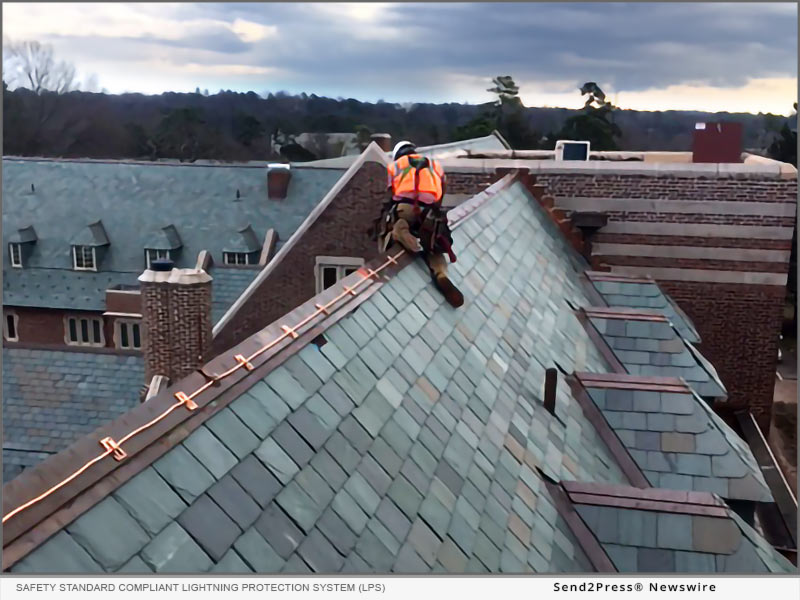
In Support of National Lightning Safety Awareness Week June 19-25, 2022
CUMBERLAND, Maine /Massachusetts Newswire – National News/ — Old and new myths about lightning protection continue to circulate through the internet and unsafe lightning protection products still manage to find their way into construction job specifications in many parts of the U.S. To help safeguard properties from a leading weather threat, the National Lightning Safety Council (NLSC) is stressing the importance of separating fact from fallacy about lightning protection systems (LPS).
“Despite the wealth of accurate information on lightning, lightning safety and lightning protection, there are still many myths and misunderstandings that persist,” said John Jensenius, a lightning safety specialist with the NLSC.
Just in time for Lightning Safety Awareness Week, the NLSC debunks five common myths about lightning protection:
1 – Lightning rods attract lightning
Unfortunately, this is a common misconception about lightning protection. Lightning protection systems and strike termination devices (industry name for lightning rods which are part of the system) work in conjunction with a grounding network to intercept a lightning strike and provide a safe and effective path that dissipates lightning’s harmful electricity into the earth.
2 – Tall trees protect a structure against lightning
False. Lightning can side-flash from a tree and hit a nearby structure. Additionally, when lightning strikes and travels underground along tree roots, it can enter a structure by jumping onto nearby telephone, cable and electrical lines, introducing harmful surges. Lightning can also injure a tree from a direct strike, causing limbs to split and fall onto a nearby structure.
3 – Homes and building are already grounded and don’t need lightning protection
The electrical ground installed by an electrician is there to protect the internal workings of the electrical system in a building to accommodate everyday electricity usage-it’s not designed to handle the mega electricity (100 million + volts of power or 200 kA of electrical energy!) that a lightning strike can pack.
4 – A lightning rod is easy to install
Lightning protection is a complex system (not just a “rod”) of UL-listed materials and methods which comply with nationally-recognized safety standards of the Lightning Protection Institute (LPI), the National Fire Protection Association (NFPA) and Underwriters Laboratories (UL). LPS is not a do-it-yourself project. Only trained experts like LPI-certified lightning protection contractors should install lightning protection systems, since design and installation is rarely within the scope of expertise held by homeowners, general contractors or roofers.
5 – Surge protection and “whole house” arresters protect structures from lightning
False. Surge protection is only one element of a complete lightning protection system. A grounding network for lightning (lightning protection system) must be implemented to provide structural protection. A LPS that meets national safety standards includes strike termination devices, down conductors, bonding, grounding and UL-rated surge protection devices.
“Lightning just wants to get to ground and a safety standard compliant lightning protection system helps it get there without harmful impact to the structure, contents or building systems,” said Kimberly Loehr, a lightning protection specialist and member of the NLSC. “The concept is simple, but the safety standards are complex and detail principles including zone of protection, common bonding of grounded systems, potential equalization of ground impedance, lightning risk assessment and much more,” explained Loehr.
People looking to learn more about lightning safety, risk reduction and the annual Lightning Safety Awareness Week campaign, June 19-25, 2022, can visit http://www.lightningsafetycouncil.org/.
MULTIMEDIA:
PHOTO link for media: https://www.Send2Press.com/300dpi/22-0617-s2p-lps-grounding-300dpi.jpg
Photo Caption: A safety standard compliant lightning protection system (LPS) functions as a grounding network to intercept a lightning strike and provide an effective path for dissipating lightning’s destructive electricity into the earth without harmful impact to a structure, its contents or building systems.
RELATED LINKS:
http://www.lightningsafetycouncil.org/LSC-LSAW.html
https://lightning.org/about/find-a-contractor/
Learn More: http://lightningsafetycouncil.org/
This version of news story was published on and is Copr. © 2022 Massachusetts Newswire™ (MassachusettsNewswire.com) – part of the Neotrope® News Network, USA – all rights reserved.
Information is believed accurate but is not guaranteed. For questions about the above news, contact the company/org/person noted in the text and NOT this website.





